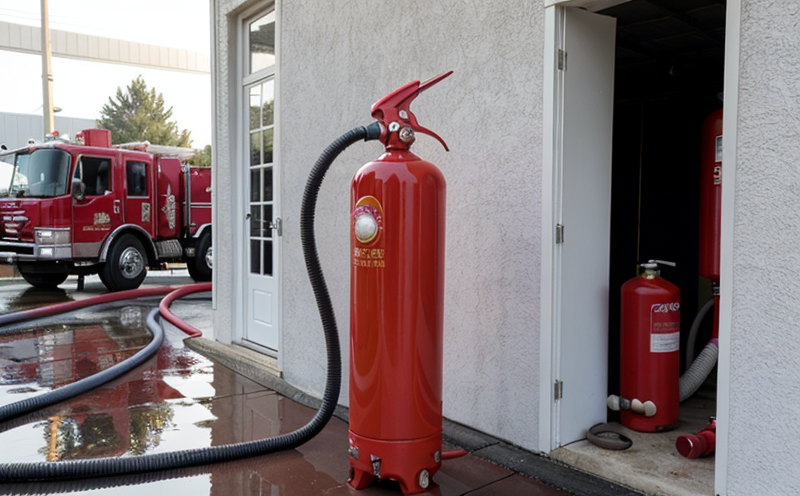Water-based fire extinguisher inspection
The inspection of water-based fire extinguishers is a critical component in ensuring workplace safety. Water-based fire extinguishers are designed to combat Class A fires, which involve ordinary combustibles like wood, paper, or cloth. Proper inspection ensures that these extinguishers remain effective and ready for use when required.
The importance of water-based fire extinguisher inspections cannot be overstated in various sectors such as manufacturing, logistics, hospitality, and retail. These industries often have large volumes of materials that are susceptible to fire hazards. Regular inspections help identify any potential issues with the extinguishers before they can lead to a serious incident.
Water-based fire extinguishers must meet specific standards to ensure their effectiveness. One such standard is ISO 14039:2018, which specifies the requirements and test methods for water-based fire extinguishers. Compliance with these standards ensures that the extinguishers are reliable and effective in extinguishing fires.
During an inspection, several key aspects are evaluated to ensure the extinguisher's readiness. These include checking the pressure gauge to confirm it is within the safe operating range, inspecting the nozzles for any blockages or damage, verifying that the container is not corroded or leaking, and ensuring that the pin and lever function correctly.
Water-based fire extinguishers must also be regularly recharged according to manufacturers' recommendations. This process involves draining the extinguisher, replacing the old water with fresh water, and refilling it as needed. Proper recharging ensures that the extinguisher remains effective for years of use.
The inspection should be conducted by qualified personnel who are familiar with fire safety equipment. These individuals must have undergone training in accordance with relevant standards to ensure they can perform the inspections accurately and effectively. Regular inspections help maintain a safe working environment, reducing the risk of fires and potential injuries or fatalities.
Compliance officers play a crucial role in ensuring that all fire extinguishers are inspected regularly. They should establish an inspection schedule based on the manufacturer's recommendations and ensure that all personnel involved in the process follow best practices.
R&D engineers may also benefit from understanding the standards and requirements for water-based fire extinguisher inspections. This knowledge can help them design more effective and safer products, ensuring they meet or exceed industry expectations.
Proper inspection of water-based fire extinguishers is essential in preventing fires and protecting lives. By adhering to established standards and guidelines, organizations can ensure that their fire safety equipment remains effective and reliable.
Applied Standards
The inspection of water-based fire extinguishers must comply with several international standards. One such standard is ISO 14039:2018, which specifies the requirements and test methods for water-based fire extinguishers.
| Requirement | Description |
|---|---|
| Visual Inspection | The exterior of the extinguisher should be inspected for any signs of damage, corrosion, or leakage. |
| Pressure Gauge Check | The pressure gauge should indicate that the extinguisher is within its safe operating range. |
| Nozzle Inspection | The nozzle must be free from blockages and in good working condition. |
| Lever Functionality | The lever mechanism should operate smoothly without any sticking or obstruction. |
| Recharging Schedule | Water-based fire extinguishers require regular recharging to ensure they remain effective. This schedule is based on the manufacturer's recommendations and local regulations. |
Compliance with these standards ensures that water-based fire extinguishers are reliable and effective in extinguishing fires, providing peace of mind for those responsible for maintaining them.
Scope and Methodology
The scope of a water-based fire extinguisher inspection includes several key areas. The first step is to visually inspect the exterior of the extinguisher for any signs of damage, corrosion, or leakage. This examination helps identify potential issues that could affect the extinguisher's performance.
Next, the pressure gauge should be checked to ensure it indicates a safe operating range. A malfunctioning pressure gauge can indicate problems with the internal components of the extinguisher, making regular checks essential. The nozzle must also be inspected for any blockages or damage, ensuring that water flows freely and evenly during discharge.
The lever mechanism should operate smoothly without any sticking or obstruction. This ensures that the lever can be easily pulled to activate the extinguisher when needed. If the lever is stuck or difficult to pull, it may indicate internal issues that require immediate attention.
Water-based fire extinguishers must also be regularly recharged according to manufacturers' recommendations and local regulations. This process involves draining the extinguisher, replacing the old water with fresh water, and refilling it as needed. Proper recharging ensures that the extinguisher remains effective for years of use.
The inspection should be conducted by qualified personnel who are familiar with fire safety equipment. These individuals must have undergone training in accordance with relevant standards to ensure they can perform the inspections accurately and effectively. Regular inspections help maintain a safe working environment, reducing the risk of fires and potential injuries or fatalities.
International Acceptance and Recognition
The inspection of water-based fire extinguishers is widely accepted and recognized across many countries due to its importance in ensuring workplace safety. Compliance with international standards such as ISO 14039 ensures that the inspections meet global expectations for effectiveness and reliability.
Many industries, including manufacturing, logistics, hospitality, and retail, rely on properly inspected water-based fire extinguishers to protect their facilities from fires. Regular inspections help maintain a safe working environment, reducing the risk of fires and potential injuries or fatalities.
The inspection process is standardized across different regions, with slight variations in local regulations. However, adherence to international standards ensures consistency in quality and effectiveness. This approach helps organizations comply with local laws while maintaining high standards of safety.
By adhering to established standards and guidelines, organizations can ensure that their fire safety equipment remains effective and reliable. This commitment to safety not only protects lives but also contributes to a positive reputation for the organization.





